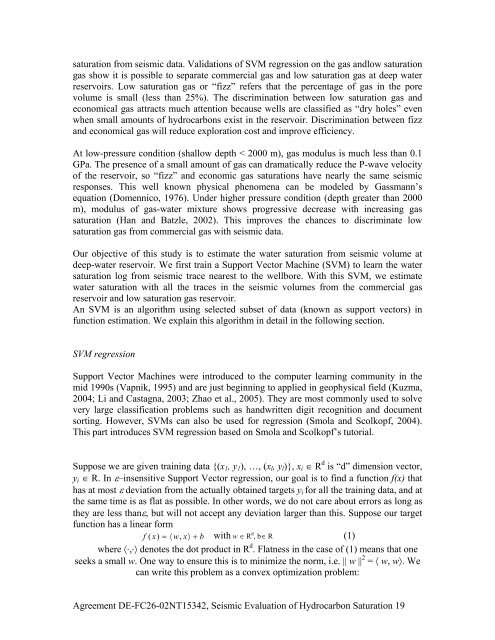Agreement DE-FC26-02NT15342, Seismic Evaluation of ...
Agreement DE-FC26-02NT15342, Seismic Evaluation of ...
Agreement DE-FC26-02NT15342, Seismic Evaluation of ...
You also want an ePaper? Increase the reach of your titles
YUMPU automatically turns print PDFs into web optimized ePapers that Google loves.
saturation from seismic data. Validations <strong>of</strong> SVM regression on the gas andlow saturation<br />
gas show it is possible to separate commercial gas and low saturation gas at deep water<br />
reservoirs. Low saturation gas or “fizz” refers that the percentage <strong>of</strong> gas in the pore<br />
volume is small (less than 25%). The discrimination between low saturation gas and<br />
economical gas attracts much attention because wells are classified as “dry holes” even<br />
when small amounts <strong>of</strong> hydrocarbons exist in the reservoir. Discrimination between fizz<br />
and economical gas will reduce exploration cost and improve efficiency.<br />
At low-pressure condition (shallow depth < 2000 m), gas modulus is much less than 0.1<br />
GPa. The presence <strong>of</strong> a small amount <strong>of</strong> gas can dramatically reduce the P-wave velocity<br />
<strong>of</strong> the reservoir, so “fizz” and economic gas saturations have nearly the same seismic<br />
responses. This well known physical phenomena can be modeled by Gassmann’s<br />
equation (Domennico, 1976). Under higher pressure condition (depth greater than 2000<br />
m), modulus <strong>of</strong> gas-water mixture shows progressive decrease with increasing gas<br />
saturation (Han and Batzle, 2002). This improves the chances to discriminate low<br />
saturation gas from commercial gas with seismic data.<br />
Our objective <strong>of</strong> this study is to estimate the water saturation from seismic volume at<br />
deep-water reservoir. We first train a Support Vector Machine (SVM) to learn the water<br />
saturation log from seismic trace nearest to the wellbore. With this SVM, we estimate<br />
water saturation with all the traces in the seismic volumes from the commercial gas<br />
reservoir and low saturation gas reservoir.<br />
An SVM is an algorithm using selected subset <strong>of</strong> data (known as support vectors) in<br />
function estimation. We explain this algorithm in detail in the following section.<br />
SVM regression<br />
Support Vector Machines were introduced to the computer learning community in the<br />
mid 1990s (Vapnik, 1995) and are just beginning to applied in geophysical field (Kuzma,<br />
2004; Li and Castagna, 2003; Zhao et al., 2005). They are most commonly used to solve<br />
very large classification problems such as handwritten digit recognition and document<br />
sorting. However, SVMs can also be used for regression (Smola and Scolkopf, 2004).<br />
This part introduces SVM regression based on Smola and Scolkopf’s tutorial.<br />
Suppose we are given training data {(x 1 , y 1 ), …, (x l , y l )}, x i ∈ R d is “d” dimension vector,<br />
y i ∈ R. In ε–insensitive Support Vector regression, our goal is to find a function f(x) that<br />
has at most ε deviation from the actually obtained targets y i for all the training data, and at<br />
the same time is as flat as possible. In other words, we do not care about errors as long as<br />
they are less thanε, but will not accept any deviation larger than this. Suppose our target<br />
function has a linear form<br />
f ( x)<br />
= 〈 w,<br />
x〉<br />
+ b with w ∈ R d , b∈ R (1)<br />
where 〈⋅,⋅〉 denotes the dot product in R d . Flatness in the case <strong>of</strong> (1) means that one<br />
seeks a small w. One way to ensure this is to minimize the norm, i.e. || w || 2 = 〈 w, w〉. We<br />
can write this problem as a convex optimization problem:<br />
<strong>Agreement</strong> <strong>DE</strong>-<strong>FC26</strong>-<strong>02NT15342</strong>, <strong>Seismic</strong> <strong>Evaluation</strong> <strong>of</strong> Hydrocarbon Saturation 19
















